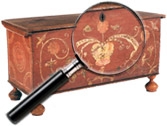|
|
Mustard
The word mustard is thought to come from two words: “mustum,” a Latin word for young wine, which is called must, and “ardens,” a Latin word for hot. It was a hot condiment made by grinding mustard seeds up with must to form a paste, and still today as a condiment made from mustard seeds (whole, ground, or cracked) and mixed with a liquid like water or lemon juice to create a paste, [...] Click here to continue reading.
Zoar
In the 1810s, a group of German religious separatists left Wurttemberg in what is now southwestern Germany, after several decades of separation from the primary church in the region, the Lutheran Church. After years of persecution and oppression which included imprisonment and property seizures, the separatists, under the leadership of Joseph Bimeler (sometimes Baumeler), decided to flee to the United States in the hopes that they could establish a new community there.
One [...] Click here to continue reading.
Captain Hall J. Tibbits (American, 1797 to 1872)
This article about the life and career of Captain Tibbits by Eric C. Rodenberg appeared on the 4 November 2013 front page of Antique Week’s National Section. Used by permission. http://www.antiqueweek.com.
1800s Sea Captain’s Life Told Through Collection
At 6 foot, 4 inches tall and “powerfully built” Capt. Hall Jackson Tibbits would brook no foolishness.
After his “religious principles” were violated by passengers dancing on [...] Click here to continue reading.
Collection of Florence P. and William W. Griffin
Bill and Florence Griffin met at an Atlanta Bird Club meeting in 1945. Bill was a published amateur ornithologist; Florence was interested in all of nature – she knew the names of all the plants as well as the birds.
Both were from Georgia, and soon began to see their state changing before their eyes as the New South swept away the Old. They quickly became [...] Click here to continue reading.
Bakelite
Scandal & the Story of Bakelite Bakelite hit the market in 1907, heralding the arrival of the modern plastics industry. Bakelite was the first completely man made plastic, as until then, plastics such as celluloid, casein, and Gutta-Percha all had as a base a natural material. It was developed by Belgian-born chemist Dr. Leo Hendrick Baekeland who started his firm General Bakelite Company to produce the phenolic resin type plastic. Bakelite was inexpensive [...] Click here to continue reading.
Chrome by Chase- The Art Deco Years
The Art Deco style may have originated in Europe, but Americans embraced it for everything from skyscrapers to soap dishes, and nobody did it better than Chase.
First Waterbury, then Chase Art Deco buildings like the Chrysler Building and Radio City Music Hall in New York, the Union Terminal in Cincinnati, and much of Miami Beach needed lighting and accessories to go with this exciting new [...] Click here to continue reading.
William F. “Buffalo Bill” Cody
The year 1883 neatly divides William Cody’s former life as a hunter, scout and guide from his later career as a showman. He was 37 in this year of transition.
The early life of William Frederick Cody (1846 to 1917) was colorful, adventurous and, thanks to Dime novels, exaggerated. He fought for the Union Army in the Civil War at 18. By 21, he earned his lifelong nickname [...] Click here to continue reading.
Vermeil
“Vermeil” is a French word co-opted by the English in the 19th century for a silver gilt process. Vermeil is a combination of silver and gold, although other precious metals are also occasionally added, that is then gilded onto a sterling silver object. The reddish (vermilion) hue of the addition of the gold gives the product its name. Vermeil is commonly found in jewelry, and a standard of quality (10 karat gold) and [...] Click here to continue reading.
R. Wittingham N. York Detail of the ‘R Wittingham N York’ stamp, p4A item D9848534
“R. Wittingham N. York” is a misspelled mark used by the brass founders Richard Whittingham, Sr. (1747 to 1821) and his son Richard Whittingham, Jr. (born 1776). It is found impressed on high-quality brass andirons of the period 1800 to 1821. Richard Sr. was active as an American brass founder from 1795 to 1818; his son Richard Jr. is [...] Click here to continue reading.
Hoosier and Hoosier Cupboards
The word “Hoosier” is one of those words whose origins are lost to time. Even The Oxford English Dictionary offers no real guidance about where the word came from. What we do know is that “Hoosier” was first documented in the mid-1820s, and within a decade, it had entered general usage. John Finley, a Hoosier himself from Richmond, write a poem titled, “The Hoosier’s Nest” that was published in 1833, [...] Click here to continue reading.
|
Recent Articles
- Charles Alfred Meurer – American Artist & Tromp L’Oeil Artist
- Sendak, Maurice – American Artist & Writer
- Godie, Lee – American Artist
- Davis, Vestie – American Artist
- Bartlett, Morton – American Artist
- Mackintosh, Dwight – American Artist
- Evans, Minnie Jones – African-American Artist
- Mumma, Ed (Mr. Eddy) – American Artist
- Nice, Don – American Artist
- Savitsky, John (Jack) – American Artist
- Gordon, Harold Theodore (Ted) – American Artist
- Dial, Thornton – African-American Artist
- Doyle Sam – American Artist
- Johnson, Lester Frederick – American Artist
- Finster, Howard – American Artist
|
|
